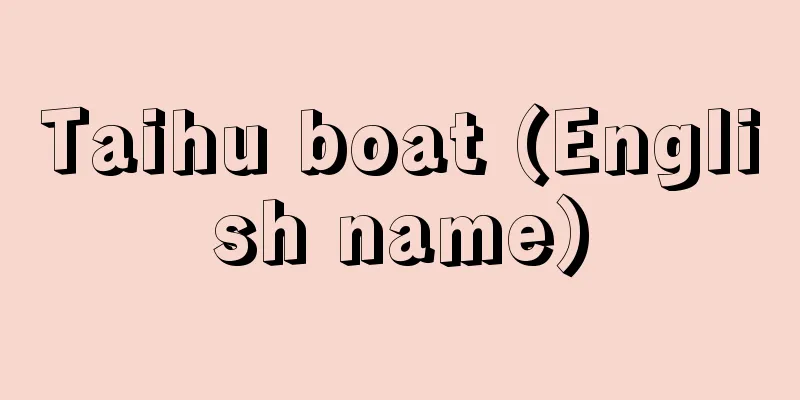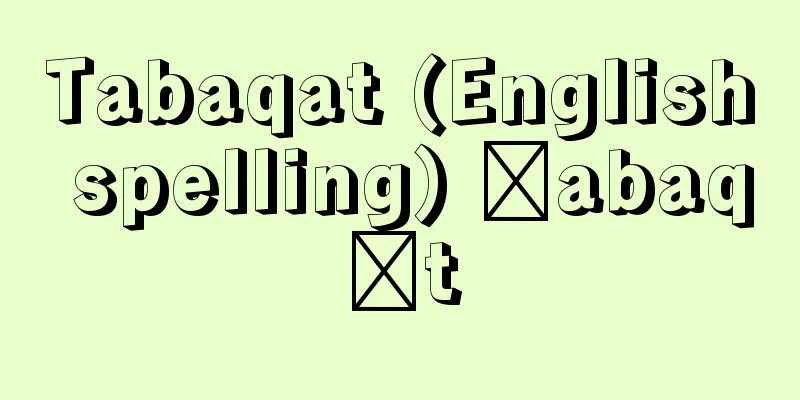Christian - Kirishitan

|
Japanese Christians (Catholics) from the end of the Sengoku period to the Edo period. The word Kirishitan comes from the Portuguese christão, cristão (Christian). The Christian faith or the Christian sect was called Kirishitan da ade, also from Portuguese. After Francis Xavier, early Christian missionary work was carried out under the protection of the Portuguese king, and church terminology was in Latin and Portuguese, so Japanese converts were called Kirishitan. When written in kanji, examples include "Kichiri Shitan," "Kirishitan," "Kirishitan," and "Ikuri Shitan," but after 1680 (Enpo 8), the character "Kichi" was no longer used to avoid the given name of the fifth Tokugawa Shogun, Tsunayoshi. Furthermore, because the Christian sect was strictly prohibited by the shogunate, descriptions of Christians that are full of malice and hatred, such as "Kirishitan" (Christian), "Oni-zato", "Kiri-shi-tan" (devilish), and "Kiri-shi-tan" (criminal sinner), appear in various documents. [Takeichi Matsuda] historyThe history of Christianity is one part of the history of East-West relations, so it should be written from a global perspective, but because the overwhelming majority of historical materials are from the Western side and because most of the researchers are European, it has tended to be treated from the perspective of Western history. Furthermore, this history is undoubtedly the history of the Catholic Church, and from that perspective, as a diocesan history, it can be divided into the first period when it belonged to the Diocese of Goa, the second period when it belonged to the Diocese of Macau, and the third period when Japan began to appoint its own bishops. Furthermore, from the perspective of Japanese history, it is possible to date it to the end of the Sengoku period, the Azuchi-Momoyama period, and the Edo period. However, if we consider the history of Christianity as unique and to date it primarily from the course of historical facts, it would go something like this: The first period was from 1549 (Tenbun 18) to 1587 (Tensho 15), when missionary work was officially recognized. During this time, the missionary work of Christianity was permitted by Shoguns Ashikaga Yoshiteru, Oda Nobunaga, and Hashiba Hideyoshi, and Christian groups were formed throughout western Japan. The second period lasted for 27 years from 1587 to 1614 (Keicho 19), and can be described as a period of tacit acceptance of missionary work. This period lasted from the time Toyotomi Hideyoshi issued the edict to expel the missionaries to the Edo Shogunate, until the Edo Shogunate actually expelled the missionaries from the country and issued an edict banning Christianity. During this period, Christian sects were tacitly accepted and had the largest number of adherents. The third period was from 1614 to 1640 (Kan'ei 17), a time of prohibition and persecution. By the end of this period, all missionaries had been executed or imprisoned, and no Christians were openly professing their faith. Therefore, the history of Christian missionary work can be said to have ended around 1640. However, in 1708 (Hōei 5), an Italian priest named Giovanni Battista Sidotti infiltrated Yakushima alone from Manila. There were still many descendants of Christians, and the Christian faith had not disappeared completely among them. For this reason, the shogunate authorities continued to take various measures to eradicate and eliminate the Christian faith even after 1640. That is, from the Genna era (1615-24) to the Kan'ei era (1624-44), the shogunate instituted systems such as the Fumie (stepping on pictures of dead bodies) and the Shumon Aratame (religious religious examination), and even posted notices encouraging people to inform on Christians. Inoue Chikugo-no-kami, who was appointed religious examination officer in 1640, traveled between Edo and Nagasaki and devoted himself to the eradication of Christians. He encouraged suspects to report, and many people were accused from all over the country. However, by the time they were accused, almost all of them had already abandoned their faith. During Inoue Chikugo-no-kami's reign, many people were executed for being Christians, but they were executed because the suspicions had not been completely cleared, and some were punished as a warning to others, for reasons such as accidentally possessing Christian relics. In 1658 (Manji 1), Hojo Awa no Kami was appointed as the religious reformer, and in 1687 (Jokyo 4), the Christian tribe system was implemented to strictly monitor converts, their surroundings, or their descendants to prevent them from returning to the Christian faith. On the other hand, in Hirado, Nagasaki, and Amakusa, there were people who maintained the Christian faith while posing as Buddhists on the surface, and these people are generally called "hidden Christians." In 1865 (Keio 1), a hidden Christian from Urakami visited Oura Cathedral in Nagasaki and confessed his faith. Although the existence of other believers was discovered, new persecutions were inflicted on believers until the beginning of the Meiji era, as the ban on Christianity continued, and it became an international issue. The ban on Christianity was not lifted until 1873 (Meiji 6). [Takeichi Matsuda] EvangelismThe missionary work of the Christian sect, or Catholicism, in Japan was started by Francis Xavier, one of the founders of the Society of Jesus. His reports to Europe had a great influence, and after that, many excellent Jesuit priests (ba-terens) and monks (i-mans) came to Japan. However, the missionary work did not progress easily. Buddhism and Shintoism had established a firm foothold in the religious world of Japan, the Japanese language was too difficult for the Nanban missionaries, Portugal's national power was already declining, it was far away from Japan, and the king of Portugal had an obligation to support the Japanese church but did not fulfill it. As a result, the Jesuits in Japan were forced to invest in the so-called Nanban trade between Macau and Japan, and use the profits from it for missionary work. Meanwhile, in Hizen, Omura Sumitada, Arima Yoshisada, and Harunobu, and in Bungo, Otomo Sorin, among others, became Christians, and in the Five Provinces of Kinai (Yamato, Yamashiro, Kawachi, Settsu, and Izumi), missionaries were favored by Ashikaga Yoshiteru and Oda Nobunaga, and the Nanbanji Temple was built in Kyoto, and the number of influential converts gradually increased. For example, in 1583 (Tensho 11), the year after the Honnoji Incident, there were approximately 150,000 Christians, with approximately 115,000 of them living in the Shimo diocese (the area centered around Omura, Arima, and Amakusa). Toyotomi Hideyoshi showed kindness to the missionaries for the first few years after he became ruler of Japan, but in 1587 (Tensho 15) he began to oppress the Christian sect. However, Hideyoshi, partly due to his connection with trade with Nanban, tacitly allowed the missionaries to live in the country when they showed their submission. As a result, in Hideyoshi's later years, the number of Christians is estimated to have increased further, reaching around 250,000. Also noteworthy during this period was the fact that Hideyoshi's recommendation to the Philippines (Luzon) to surrender prompted Dominican and Franciscan priests to come to Japan as the governor's emissaries, i.e. as diplomats. Prior to this, Pope Gregory XIII had issued a papal bull in January 1585 (December 12th year of Tensho) stating that missionary work in Japan was limited to the Society of Jesus, so when Spanish missionaries from the Philippines began their missionary work in Japan, fierce conflict arose between them and the Jesuits, and this conflict continued into the persecution period. In any case, the situation suddenly worsened when the Spanish ship San Felipe was shipwrecked at Urado in Tosa in 1596 (first year of Keicho), and Hideyoshi executed six Franciscans and 20 Japanese (three of whom were Jesuit monks) at Nishizaka in Nagasaki in February 1597 (December 1st year of Keicho). This was the martyrdom of the "Twenty-Six Martyrs of Japan." Tokugawa Ieyasu, who succeeded Toyotomi Hideyoshi, was a Buddhist and hated Christianity from the beginning, but he tolerated Christian missionary work in order to facilitate foreign negotiations. Just before the Battle of Sekigahara, Ieyasu met with Franciscan Geronimo and asked him to help with negotiations between Japan and Spain, specifically trade between Mexico and Japan across the Pacific Ocean. However, his wish was not fulfilled, and missionaries continued to arrive from the Philippines. In 1612 (Keicho 17) Ieyasu banned Christianity in the name of the shogunate, and had it carried out from his direct territories. In February 1614 (Keicho 18 December), he had Konchiin Suden draft an edict banning Christianity, and then expelled missionaries in Japan from the port of Nagasaki. At that time, at least 37 missionaries (priests) remained in Japan, prepared to be martyred. After that, some infiltrated Japan from abroad, others were arrested, imprisoned, and executed, and a deadly battle unfolded between the shogunate and the Christians, eventually leading to a situation where not a single priest was living in Japan. [Takeichi Matsuda] Reasons for the banThere have been many discussions about the reasons why Japan suppressed and then strictly banned Christianity (called the Kirishitan sect at the time) in the early modern period, but today it is recognized that scholars of Japan both in Japan and abroad agree on this issue. When Toyotomi Hideyoshi issued the so-called "Edict to Expel the Missionaries" in 1587 (Tensho 15), he pointed out that the reason given in the edict, that Japan was a "divine country," was not accepted internationally or theologically, but it was unforgivable for missionaries and Christian daimyo to destroy shrines and temples and forcibly convert people to Christianity. Later, in a letter to the governor-general of the Philippines, Hideyoshi wrote, "You are probably using the spread of the Christian sect as a means of acquiring overseas territories," and added, "If the Japanese were to do in your country what your people are doing in Japan, you would also prohibit them." Although Hideyoshi and Ieyasu did not know the details of what the Spanish conquerors had done in both the Aztec and Incan countries, and even though it was impossible for the Spanish and Portuguese to occupy Japan militarily from the end of the 16th century to the beginning of the 17th century, it was only natural for them, as Japanese rulers, to prohibit Christian missionary work, since they considered it to have other than a purely religious purpose. Some missionaries in Japan, frustrated that their missionary work was not going as planned, had the unreasonable idea of relying on Spanish military power to fortify somewhere in western Japan as a church base to stand up to the Japanese government authorities, and in fact, at least temporarily, the cape of Nagasaki became church property and was fortified. The Japanese are originally accustomed to polytheism and are a very tolerant people when it comes to religion. Therefore, for the first few decades after the introduction of Christianity, the sect was not persecuted. However, there were good reasons why it was banned during the reign of Hideyoshi and Ieyasu. Missionaries' reports on the number of Christians do not agree, with some stating 800,000 or 900,000, but the most reliable estimate is that there were 220,000 Japanese Christians under the guidance of the Jesuits in 1610 (Keicho 15). Therefore, at their peak, the number would have been around 300,000 to 400,000. [Takeichi Matsuda] "The Rise and Fall of Christian Missionary Works, by Anesaki Masaharu (1930, Dobunkan)" ▽ "Persecution and Hiding of the Christian Religion, by Anesaki Masaharu (1925, Dobunkan)" ▽ "The History of Japanese Christians, by Ebisawa Arimichi (1966, Hanawa Shobo)" ▽ "The History of the Martyrdom of Japanese Christians, by Kataoka Yakichi (1979, Jiji Press)" ▽ "Encounter with the West, by Matsuda Takeichi (1982, Asahi Shimbun)" [References] | | | | | [Supplementary material] | |©Shogakukan "> Christian missionary work and educational institutions Source: Shogakukan Encyclopedia Nipponica About Encyclopedia Nipponica Information | Legend |
|
戦国時代の末期から江戸時代における日本人キリスト教(カトリック)信者。キリシタンの語はポルトガル語のchristão, cristão(キリスト教徒)に由来する。キリシタン信仰、またはキリシタン宗門は同じくポルトガル語からキリシタンダアデと称された。フランシスコ・ザビエル以後、初期のキリスト教の布教はポルトガル国王の保護権下に行われ、教会用語はラテン語とポルトガル語であったから、日本人の改宗者はキリシタンとよばれた。これを漢字で表す場合に、「吉利支丹」「貴利支丹」「貴理師端」「幾里志丹」などの例がみられるが、1680年(延宝8)以後は、徳川5代将軍綱吉の諱(いみな)を避けて「吉」を用いなくなった。またキリシタン宗門は幕府が厳禁するところであったから、キリシタンには「切支丹」「鬼里至端」「切死端」「毀理至炭」といった悪意や憎悪を交えた表現が諸文献にみえる。 [松田毅一] 歴史キリシタンの歴史は東西交渉史の一こまであるから、世界的視野から叙述されるべきであるが、史料が西洋側に圧倒的に多いことや、研究者にヨーロッパ人が多かったこともあって、西洋史の観点から扱われる傾向があった。また、この歴史はカトリック教会史に違いなく、その観点からは、司教区史として、ゴア司教区に属していた第1期、マカオ司教区に属した第2期、日本に独自の司教が任命されるようになった第3期と分けることもできる。さらに日本史の観点からは、戦国時代末期、安土桃山(あづちももやま)時代、江戸時代でくぎることも可能である。だがキリシタンの歴史を独自のものとみなし、主として史実の経過からくぎるならば次のようになる。 すなわち、第1期は1549年(天文18)から1587年(天正15)までで、布教が公認された時代。この間、足利(あしかが)将軍義輝(よしてる)、織田信長、羽柴秀吉(はしばひでよし)らによってキリシタンの布教が認められ、西日本各地にキリシタンの集団が形成された。第2期は1587年から1614年(慶長19)までの27年間で、布教黙認の時代といいうる。すなわち、豊臣秀吉(とよとみひでよし)がバテレン(宣教師)追放令を発令してから、江戸幕府がバテレンらを実際に国外追放し、かつキリシタンの禁令を発布するまでで、この間、キリシタン宗門は黙認されており、信徒の数ももっとも多かった。第3期は1614年から1640年(寛永17)までで、禁教と迫害の時代である。この時代の終わりには、宣教師はすべて処刑されたり投獄されたし、キリシタン信徒も公然と信仰を表明する者はなくなった。したがってキリシタンの布教史はこの1640年ごろで終わるといえる。ただし1708年(宝永5)にはマニラから単身で屋久島(やくしま)に潜入してきたイタリア出身の司祭ジョバンニ・バッティスタ・シドッチがいる。またキリシタンの子孫はなお大ぜいいて、キリシタンの信仰が彼らの間でまったく消滅したのでもない。そのために幕府当局は、1640年以後もなおキリシタン信仰を殲滅(せんめつ)し根絶させるために種々の手段を講じた。 すなわち幕府は元和(げんな)(1615~24)から寛永(かんえい)(1624~44)にかけて踏絵(ふみえ)や宗門改(しゅうもんあらため)の制度を設け、さらにはキリシタンの密告を奨励する高札を掲げた。1640年宗門改役に任ぜられた井上筑後守(ちくごのかみ)は江戸と長崎の間を往来しつつキリシタンの殲滅に専念し、嫌疑者を訴え出ることを奨励したので、全国各地からおびただしい人々が告訴された。だが彼らは訴えられたときには、ほとんどすべてすでに棄教していた。井上筑後守の代に大ぜいがキリシタンの科(とが)で処刑されているが、彼らは嫌疑が完全に晴れないために処刑されたのであり、なかにはキリシタン関係の遺物をたまたま所持していたなどの理由で、見せしめのために罰せられた者もいる。1658年(万治1)に北条安房守(あわのかみ)が宗門改役に就任し、1687年(貞享4)には、転宗者とその周辺、あるいは子孫のうちからキリシタン信仰に立ち返る者が出ないように厳重に監視しようとして、キリシタン類族制が施行された。他方、平戸(ひらど)や長崎、天草(あまくさ)方面には、集団的かつ組織的に、表面は仏教徒を装いながらキリシタン信仰を保持する人々がいた。これらの人々を一般には「隠れキリシタン」と称している。1865年(慶応1)長崎大浦天主堂に浦上の隠れキリシタンが訪れて信仰を告白した。ほかにも信徒の存在は判明したが、禁教策が続いていたため明治初年に至るまで信徒には新たな弾圧が加えられ、国際問題となった。そしてキリシタンの禁制が解けたのは1873年(明治6)のことであった。 [松田毅一] 布教日本におけるキリシタン宗門、すなわちカトリックの布教は、イエズス会の創立者の一人であるフランシスコ・ザビエルによって開始された。彼のヨーロッパあての報告書は大きな影響を与え、その後日本へは優れたイエズス会の司祭(バテレン)や修道士(イルマン)が続々渡来した。しかし布教事業は容易にはかどらなかった。仏教や神道が日本の宗教界に揺るぎない地盤を築いていたほかに、日本語は南蛮のバテレンたちにとってあまりにもむずかしく、またポルトガルはすでに国力が衰えつつあったし、日本からは遠く隔たり、同国王は日本の教会を援助する義務があったが、それを果たさなかった。そのために在日イエズス会員は、マカオと日本間の、いわゆる南蛮貿易に投資し、その収益を布教費にあてざるをえなくなった。その一方、肥前では大村純忠(おおむらすみただ)、有馬義貞(ありまよしさだ)・晴信(はるのぶ)、豊後(ぶんご)では大友宗麟(おおともそうりん)らがキリシタンとなり、五畿内(ごきない)(大和(やまと)、山城(やましろ)、河内(かわち)、摂津(せっつ)、和泉(いずみ)の5か国)でも、宣教師たちは足利義輝(よしてる)、織田信長らから寵愛(ちょうあい)され、京都には南蛮寺(なんばんじ)も建てられて、有力な改宗者もしだいに数を増した。本能寺の変の翌年1583年(天正11)を例にとれば、当時のキリシタン信徒は約15万人、なかんずく約11万5000人が、下(しも)教区(大村、有馬、天草を中心とした地方)に集まっていた。 豊臣秀吉は、天下人になってから当初数年は宣教師たちに好意を示していたが、1587年(天正15)からキリシタン宗門を弾圧し始めた。しかし秀吉は、南蛮貿易との関係もあって、宣教師たちが恭順の意を示すと、彼らが国内に在住していることを黙認した。そのために秀吉の晩年には、キリシタンの数はさらに増加して、25万人ぐらいに達したと推定される。またこの間、注目すべきことは、秀吉がフィリピン(呂宋(ルソン))に投降を勧告したことが動機となって、かの地から総督の使者、すなわち外交官の資格でドミニコ会やフランシスコ会の司祭が来日するようになったことである。これより先、ローマ法王グレゴリウス13世は、1585年1月(天正12年12月)日本の布教はイエズス会に限るとの勅書を発していたから、フィリピンから渡来したスペイン系の宣教師たちが日本で布教を開始すると、イエズス会員との間に激しい争いが起こり、その紛糾は迫害時代になってもなお継続した。ともかく、1596年(慶長1)に土佐の浦戸にスペイン船サン・フェリペ号が漂着したことから事態は急に悪化して、秀吉はフランシスコ会員6名と日本人20名(そのうち3名はイエズス会修道士)を1597年2月(慶長元年12月)に長崎の西坂で処刑した。「日本二十六聖人」殉教事件がこれである。 豊臣秀吉の後継者となった徳川家康は、仏教徒として初めからキリシタン宗門を嫌悪していたが、対外交渉を円滑にするために、キリシタンの布教を黙認していた。家康は関ヶ原合戦の直前に、フランシスコ会のジェロニモに会い、日本とスペインの交渉、具体的には太平洋を隔てたメキシコと日本との間の貿易につき尽力を請うた。だがその後、彼の希望はかなえられず、フィリピンから続々宣教師が渡来するばかりであった。家康は1612年(慶長17)幕府の名でキリシタン宗門を禁じ、直轄領からそれを実行せしめ、1614年2月(慶長18年12月)、金地院崇伝(こんちいんすうでん)にキリシタン禁教令を起草させ、ついで、在日宣教師を長崎港から国外に追放した。そのときに、少なくとも37名のバテレン(司祭)が殉教を覚悟して、日本国内に踏みとどまった。その後は、国外から日本に潜入する者、検挙され、投獄され、処刑される者と、幕府とキリシタンの死闘が展開し、ついには日本の国内に1人の司祭も在住しない事態に立ち至る。 [松田毅一] 禁教の理由日本が近世初期にキリスト教(当時の表現ではキリシタン宗門)を弾圧し、ついで厳禁した理由については従来いろいろ論じられてきたが、現今、このことでは内外の日本学者の見解は一致していると認められる。豊臣秀吉が1587年(天正15)に、いわゆる「バテレン追放令」を出したときに、そこで述べている、わが国は「神国」だからという理由は、国際的にも神学的にも通用しないが、宣教師たちやキリシタン大名が神社仏閣を破壊させたり、領民を強制的にキリシタンに改宗させたりすることは許しがたい、と指摘していることは当然である。秀吉はその後、フィリピンの総督にあてた書状において、「あなたがたはキリシタン宗門を広めることをもって、海外領土を獲得する一手段としているのであろう」と述べ、「日本においてあなたがたの国民がしているのと同じことを、日本人があなたがたの国で行うならば、あなたもこれを禁じるであろう」と述べている。秀吉や家康が、アステカ、インカの両国においてスペイン人征服者たちが行ったことの詳細を知らなかったとはいえ、また16世紀の終わりから17世紀の初めにおいて、スペイン人やポルトガル人が日本を軍事的に占領することが不可能であったとはいえ、日本の為政者として、キリシタンの布教には純然たる宗教的意図以外のものがあるとみなして、その布教を禁じたことは当然の処置であった。在日宣教師たちのなかには、布教事業が思うにまかせぬ焦燥感から、スペインの軍事力に頼って西日本のどこかを要塞(ようさい)化し教会の基地として、日本の政府当局に立ち向かおうというような不穏当な考えの者もいたし、事実、一時的にせよ、長崎の岬が教会領となり、要塞化されたこともあった。 日本人は元来、多神教に慣れ、宗教的には甚だ寛容な国民である。したがって、キリシタン宗門が伝来してから当初数十年の間、同宗門は弾圧されはしなかった。それが、秀吉、家康の代に禁圧されるに至ったのには、それなりの理由があったといいうる。 なお、キリシタンの数について宣教師の報ずるところは一致しておらず、なかには80万とか90万の数をあげている者もあるが、1610年(慶長15)にイエズス会員の指導下にあった日本人信徒数22万というのが信用される。したがって、もっとも多い年度には30万~40万ぐらいであったろう。 [松田毅一] 『姉崎正治著『切支丹伝道の興廃』(1930・同文舘)』▽『姉崎正治著『切支丹宗門の迫害と潜伏』(1925・同文舘)』▽『海老沢有道著『日本キリシタン史』(1966・塙書房)』▽『片岡弥吉著『日本キリシタン殉教史』(1979・時事通信社)』▽『松田毅一著『西洋との出会い』(1982・朝日新聞社)』 [参照項目] | | | | | [補完資料] | |©Shogakukan"> キリシタンの布教と教育機関 出典 小学館 日本大百科全書(ニッポニカ)日本大百科全書(ニッポニカ)について 情報 | 凡例 |
<<: Prohibition of Christianity
>>: Greek alphabet - Girishamoji
Recommend
Administrative Scriveners Act
…This is roughly equivalent to the traditional sc...
Initiation
Anthropological term. Also translated as "com...
Crossandra nilotica (English spelling) Crossandra nilotica
…[Ichiro Sakanashi]. … *Some of the terminology t...
Firm's production factor demand function
...To obtain the maximum profit possible, the rat...
Kimuratake - Kimuratake
→ Onik Source : Heibonsha Encyclopedia About MyPed...
Actio (English spelling)
In Roman law, it meant a ceremonial and legal act,...
Treaty of Amity and Commerce between the United States and Japan
(1) This treaty replaced the Treaty of Amity and ...
cant
…When a train passes through a curve, centrifugal...
Honcho Hoke Genki - The Tale of the Lotus Sutra
A collection of Buddhist tales from the mid-Heian...
Samain - Saman (English spelling) Albert Samain
A French Symbolist poet hailed as the "poet ...
Jintori - Taking over a camp
It is an outdoor game for children. The players s...
Humboldt University (English spelling)
…The university was founded in Berlin in 1810 und...
Angular kyphosis
…The thoracic vertebrae are the most common spine...
Volcanology
A branch of earth science that aims to elucidate ...
Inpumon'in Daifu - Inpumon'in no Taifu
Year of death: before Shōji 2 (1200) Year of birth...









